Track Stars
With the 2025 NASCAR season getting the green flag, we look back to a 2013 story on how Wolfpack alums have helped to elevate the role of NASCAR engineers, making Sunday speed more about the science.
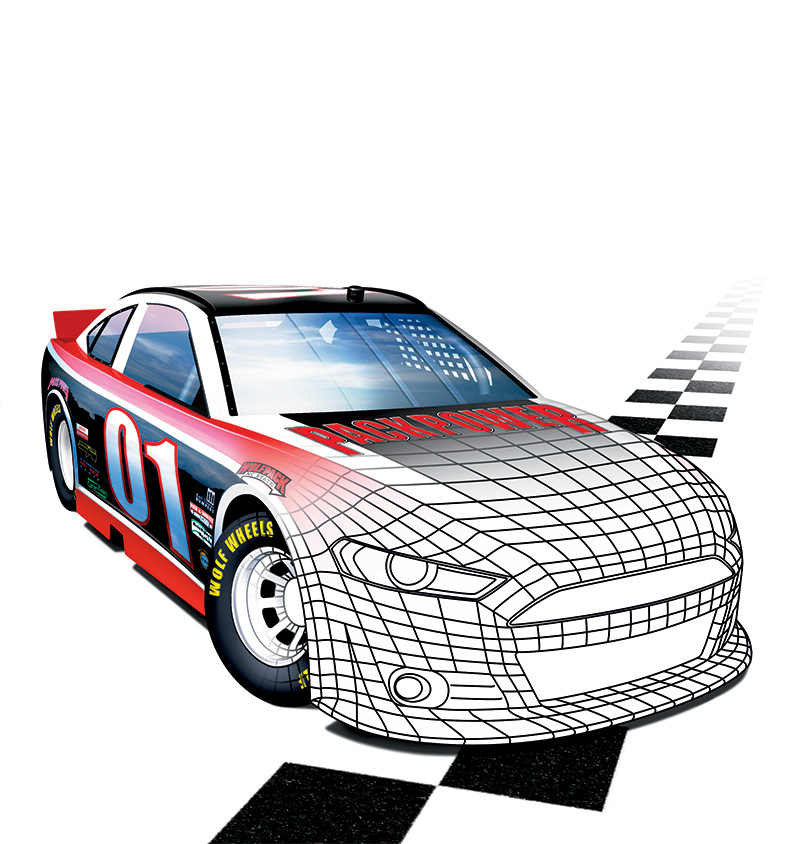
It’s the Monday afternoon after the Daytona 500, and Brian Wilson ’03 is already at his cubicle at a NASCAR garage in Mooresville, N.C., looking for an edge in the next race. Wilson is not a driver or a mechanic, but his work over the next few days will go a long way toward determining what sort of success 2012 Sprint Cup champ Brad Keselowski will have in the #2 Miller Lite Ford at Phoenix International Raceway that week and during the rest of the season.
Wilson is Keselowski’s race engineer, and much of his work is done at a desk that looks out onto the Penske Racing Facility’s garage floor with its pristine white floors that give the impression of a sterile operating room or science lab. Eight cars, their blue and white panels gleaming, sit in some stage of preparation for a future race. Wilson seldom touches the cars. Instead, he helps design those $150,000 race cars so that they cut through air and stick to the track, roaring at speeds of 190 miles per hour with a 700-horsepower V-8 engine pulsing for a heart. Mechanics use sockets and wrenches and other tools to work on the cars and engines, and Keselowski relies on his skill with brakes and the steering wheel to navigate the racetracks. But Wilson draws up the dimensions for the next car using his computer and the textbooks — Fluid Mechanics and Materials Science and Engineering — that line his desk and still wear the “used” stickers from college bookstores.
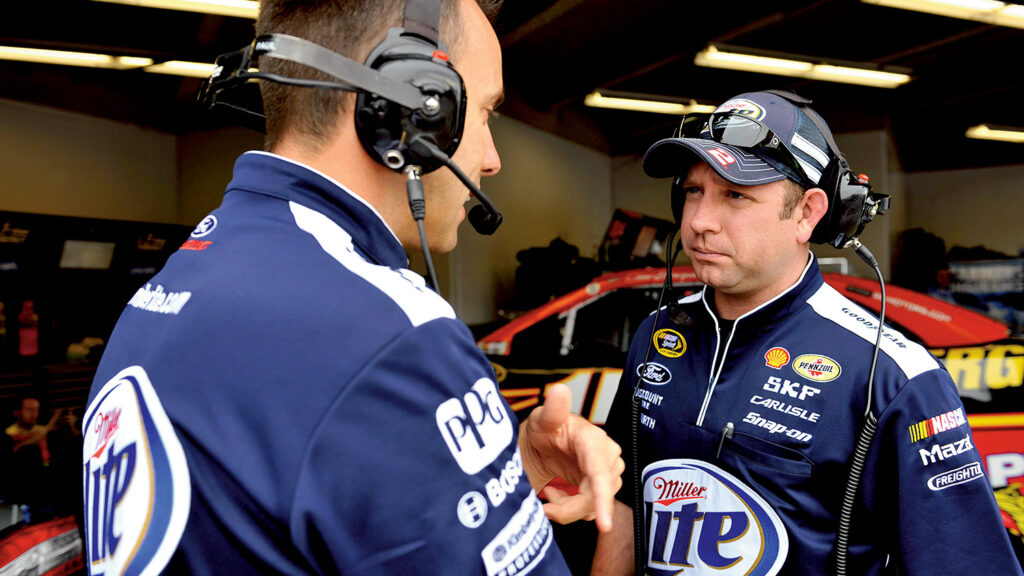
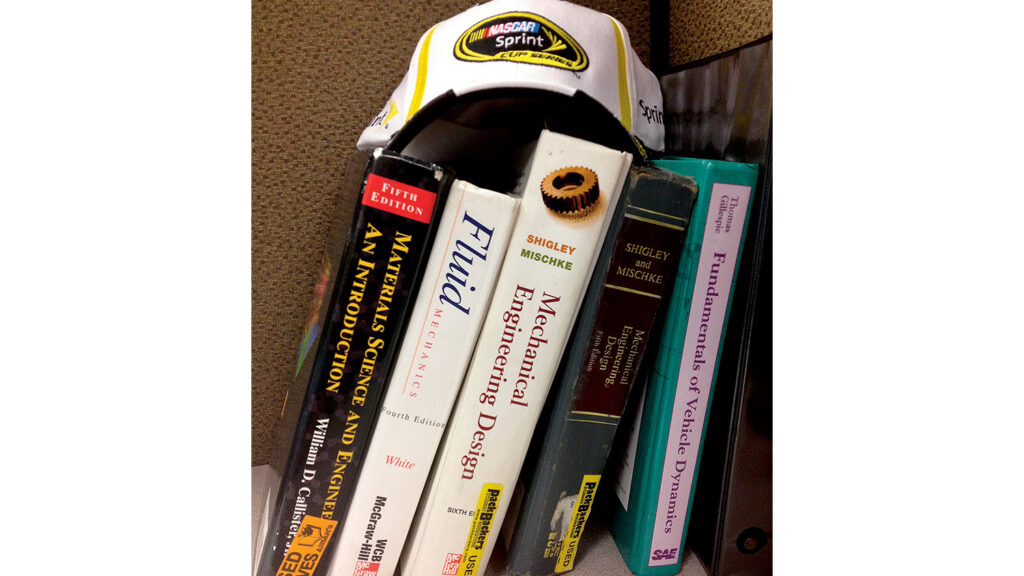
In the last 15 years, Wilson and other Wolfpack alumni like him have become a force in NASCAR, the home of American professional stock-car racing. Engineers like Bobby Hutchens ’82, who was NASCAR’s first full-time engineer with a college education, have helped change the sport with the fundamental understanding of mechanical engineering they received in NC State’s engineering classrooms and in the garage of Wolfpack Motorsports, a student-run organization at the university that allows participants the chance to apply their skills to designing, building and racing cars. The introduction of engineers into the sport came about in the late 1990s after NASCAR heavily restricted what mechanics could physically do to cars. The only advantage left came from how technology, such as wind-tunnel testing, could influence a car’s performance. “It wasn’t about what you could do with a hammer anymore,” says Dr. Jerry Punch ’75, who has covered NASCAR for radio and television since 1979.
Wilson seldom touches the cars. Instead, he helps design those $150,000 race cars so that they cut through air and stick to the track, roaring at speeds of 190 miles per hour . . .
Since then, some engineers have passed on careers with automotive companies, NASA and even the CIA to join racing teams that finance, design, build and race the cars. While racing teams’ garages once had only a couple of engineers, some now have 50 to 60 engineers who can make between $70,000 and $200,000 annually. The engineers study and manipulate a car’s aerodynamics. They work at the track on race day advising the crew chief, almost indistinguishable from the pit crew in their shirts adorned with sponsor logos. They live in the future, staying three races ahead with their designs, and have to stay on top of NASCAR’s rules changes. They have made the design process a proactive one where every part, from shock to tire, is tested to see how it affects a car’s performance.
NASCAR’s first engineers soon found they weren’t just competing against other race teams. They fought an old-guard group of racing insiders resistant to change and wary of “college boys” coming into a sport where knowledge had predominantly come from mechanics and drivers’ instincts. (Punch remembers racing legend Dale Earnhardt throwing a laptop out of a car in the mid-1990s and telling his team if they wanted to know something about the car to just ask him.) NASCAR Sprint Cup veteran Jeff Burton says the transition was rocky for engineers. “One of the things I’ve always raced on is seat-of-the-pants engineering. You take what you know and you see what your competitors are doing,” he says. “There was a fear that these engineers weren’t racers. ‘All they know is numbers.’ There was a bit of resistance.”
“Simulation is a tool that we didn’t have 10 years ago. That’s a huge part of the success you’re able to have. It has engineering fingerprints all over it.”
— Jeff Burton
Eric Warren ’91, ’93 MSE, ’97 PHD, director of competition at Richard Childress Racing, remembers that resistance when he came into racing as an engineer in the late ’90s, recounting how he was tested by an older teammate who asked him to take a tire off a car at Indianapolis Motor Speedway his first day on the job despite having no automotive experience. But he stuck with it because he saw the possibility of what science could do on Sundays and recognized that the key to an engineer’s success in racing was to look past what the car was doing and study why it was doing it.
Burton says engineers’ influence has run deep throughout NASCAR, making the use of computers an everyday part of racing. One example is simulation, or “sim” to engineers, a mathematical model using scans of all of a car’s parts and dimensions. Add to that a gumbo of other data, including the physics involved at a particular racetrack, and the engineers can see how the car will react to different variables. They also take into account factors such as when the driver hits the brakes or gives the car gas. “Simulation is a tool that we didn’t have 10 years ago,” he says. “That’s a huge part of the success you’re able to have. It has engineering fingerprints all over it.”
Sim allows Kyle McArver ’06, a race simulation engineer at Roush Fenway Racing, to see what happens to the car when a certain type of spring compresses under different track conditions or when a tire has different amounts of force bearing down on it when it goes into and comes out of a turn. And it helps race engineers with one of their primary tasks — coming up with the car’s setup for a particular race. “It’s picking your four springs,” says McArver, who adds he owes his skills to the College of Engineering’s Wolfpack Motorsport program. “Your four shocks. Picking your front sway bars. Suspension geometry. Some tire settings.”
Sim takes into account the variables of NASCAR’s different tracks: super-speedways, intermediate speedways and short tracks. Even similar tracks can make different demands on a car’s setup. Take the Bristol Motor Speedway and Martinsville Speedway, both short tracks. Bristol’s high banking creates more load on the car’s four corners, creating more grip. That means the car sticks to the track, allowing drivers to get through a corner without touching their brakes. At Martinsville, there’s no banking, so drivers must brake in a straight line. As they turn, then, the car gets loose, meaning the rear of the car skids, and the drivers are prone to braking hard and locking up their brakes. So on the week of the Martinsville race, engineers focus on braking stability so that a car won’t skid.
On race weekends, NASCAR allows teams to practice on the track for only a couple of hours. So sim enables teams to get more information that can be used to build a faster car from a lab environment. Sim also helps engineers and race teams deal with rules changes that can come down from NASCAR. NASCAR introduced a new car for the 2013 season called the Generation 6 in the hopes of making a race’s outcome more dependent upon drivers’ individual abilities. The redesign was also made to create a feeling of 1980s racing when a fan saw a car and knew it was a Chevrolet or Ford and rooted accordingly. For engineers, that means working with a blank slate in understanding the effects of the changes, like a rounder nose and taller spoiler on the rear of the car. The sim helps teams predict how cars will react to those changes.
Race engineers also have borrowed advancements in automotive manufacturing technology and transferred them to racing garages. Daniel Knost ’01, race engineer for the #39 Quicken Loans Chevrolet driven by Ryan Newman, came to Stewart-Haas in 2008 after working on his Ph.D. at Virginia Tech studying jet engine cooling. That engineering background and his scientific approach helped him find a spot working on a seven-post rig that hooks up to the car to simulate track conditions. Four hook-ups connected to the car’s wheels simulate all the bumps in a particular track’s surface, and three hydraulic hook-ups attached to the car’s body simulate downforce on the car and different banking.
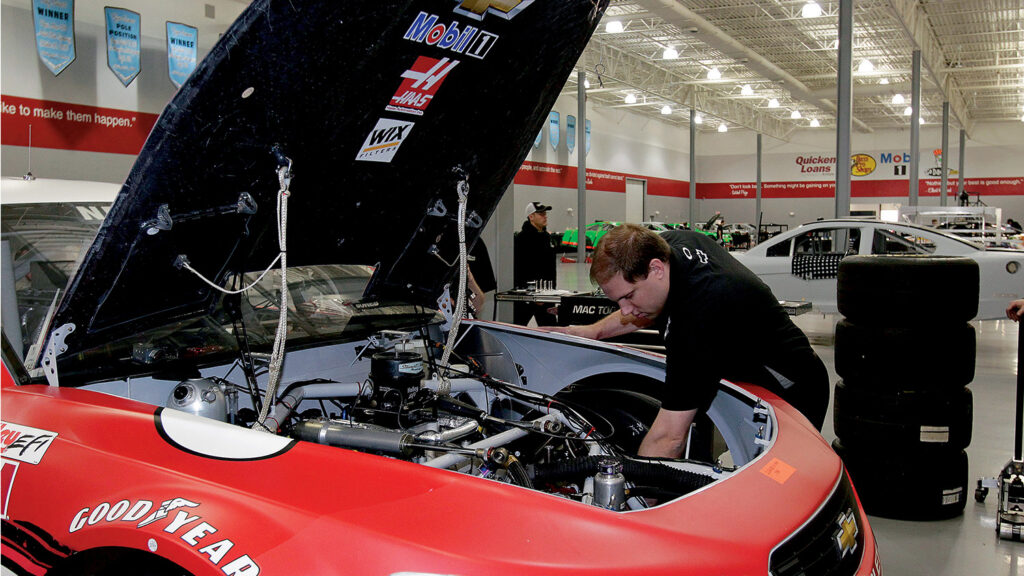
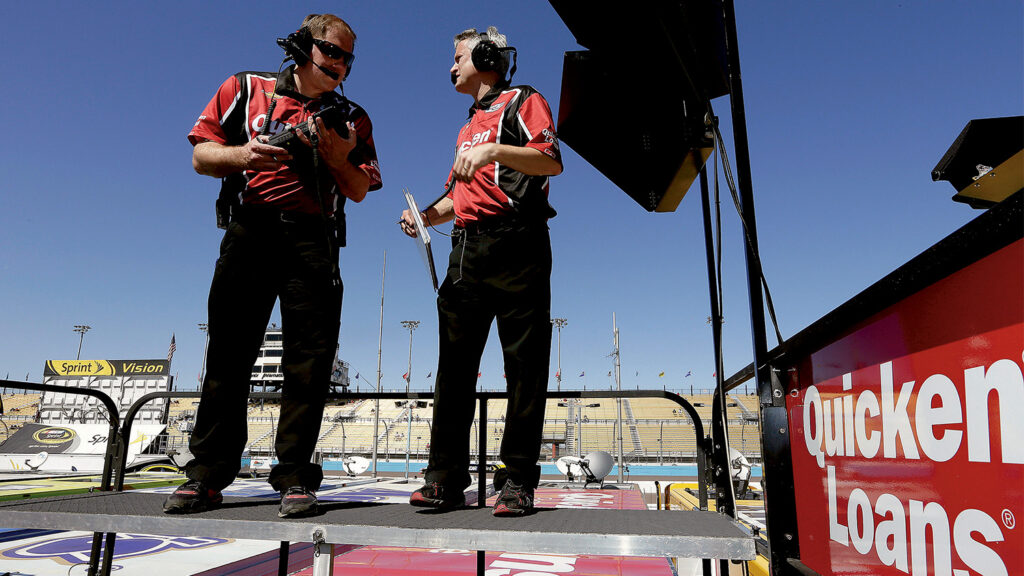
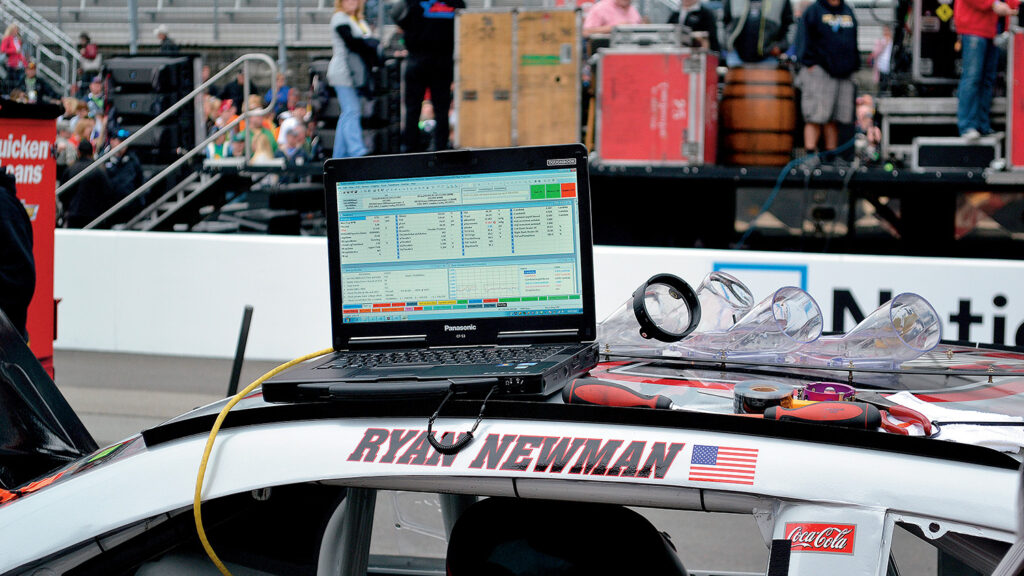
At the Stewart-Haas garage, the seven-post rig looks unassuming on the floor, with four steel plates peeking out for the wheels to sit on. But under the floor, in the garage’s belly, a jungle of power cords, some bound together by small zip ties, form the network path for the electronic data to travel. Cables connect to the seven posts that sit atop a massive block of concrete to absorb the thousands upon thousands of pounds run through the machine. Also called the “shaker rig,” it’s about a $2 million investment for a race team and was developed for car manufacturers that wanted to test noise and vibration in the 1980s and 1990s to reduce motion sickness in passengers. “So race teams came along,” Knost says, “and said, ‘We don’t necessarily care about comfort, but we care about what the car does.’ . . .We come in here and run all night, run all weekend. And we can fire all these different things at the car so we can get an idea of how each part works.”
For the race engineer, learning about each part means bouncing from the assembly room floor into the humming of the shop where all the parts and tools are built, to the fabrication room in the back where the chassis, the cars’ steel skeletons, are built while Lorretta Lynn’s “Coal Miner’s Daughter” plays in the background. The engineers are in constant dialogue with the crew chief and driver, but their most important relationship is with the car. “It’s important for me to understand Ryan [Newman] and what he means,” Knost says, “but I’m mostly concerned with the setup in the car and what it’s doing.”
While the dialogue among teams is important, talk outside of an owner’s organization doesn’t happen. It might be the smallest nugget, but any information about how one piece of the car is designed might give away an aerodynamic secret that could mean seconds in a race and valuable points in the Chase for the Sprint Cup. Warren says he was working with the Childress teams to figure out how another owner’s team was gaining an advantage with the front end of the cars. Somebody from that team’s garage posted a picture on Facebook, and Warren found the answer. “In the background was just a plain-as-day shot of the front end of their car,” he says. “You blow it up and we were like, ‘Well, here it is.’”
Gaining a competitive edge is an addiction for the engineers in the sport. Such is the case with Penske engineer Wilson, who once thought he’d literally be in the driver’s seat. He grew up around Detroit wanting to be a race car driver while his father raced. When Wilson was 4 years old, he got a go-kart to race around the backyard. He went on to race at Flat Rock Speedway in Michigan. After he came to NC State, he realized he could be an engineer and still live out his racing dream. “From watching my dad do it, I knew it was an intense sport,” Wilson says. “I knew I hadn’t been a good enough driver . . .but NASCAR is where engineers can go to compete against each other.”
Other engineers came to NASCAR with no experience or interest in cars, but with a need to fill a competitive void. Knost was such a rabid fan of NC State basketball that he followed up-to-the-minute recruiting on message boards. Since he didn’t play college basketball, he needed an outlet. He found it in NASCAR. When he talks of his respect for Newtonian physics, it’s clear that he considers competing with science just as important as competing against other teams. “It’s frustrating to have a day where you can’t find speed,” he says, drawing the comparison of determining a car’s setup to that of designing a science project. “The physics are beating you that day. Your competitors are beating you. All the puzzle pieces are in front of you, but you can’t put them together. That’s very frustrating, but it stokes your fire as an engineer.”
And then there’s Luke Lambert ’05, who proves that all the science, sim and data are no substitute for the instinct that kicks in on race day. Lambert was a longtime race engineer at Richard Childress Racing, but this season became crew chief for the #31 car driven by Burton. It’s a recent trend with more engineers taking the helm of NASCAR teams. Lambert spends the week in the garage, looking at data on the upcoming tracks. But on race day, when he wears the pressures of a head coach in football and has the final say in the decisions for the team, he realizes that science only gets him so far. He fuses his experience with the cars to his knowledge of engineering, and in the end, relies on his instinct. “I try to understand why we make the decisions we make,” he says. “But at the end of the day, we’re going with what works and I don’t care to understand it, in a sense. When your information doesn’t line up with your experience, you have to respond with your experience.”
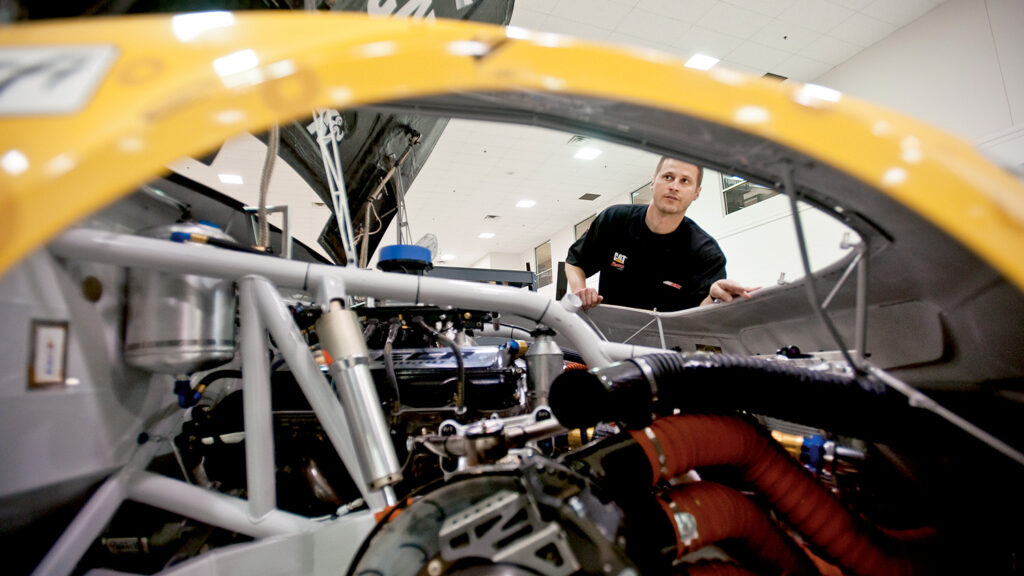
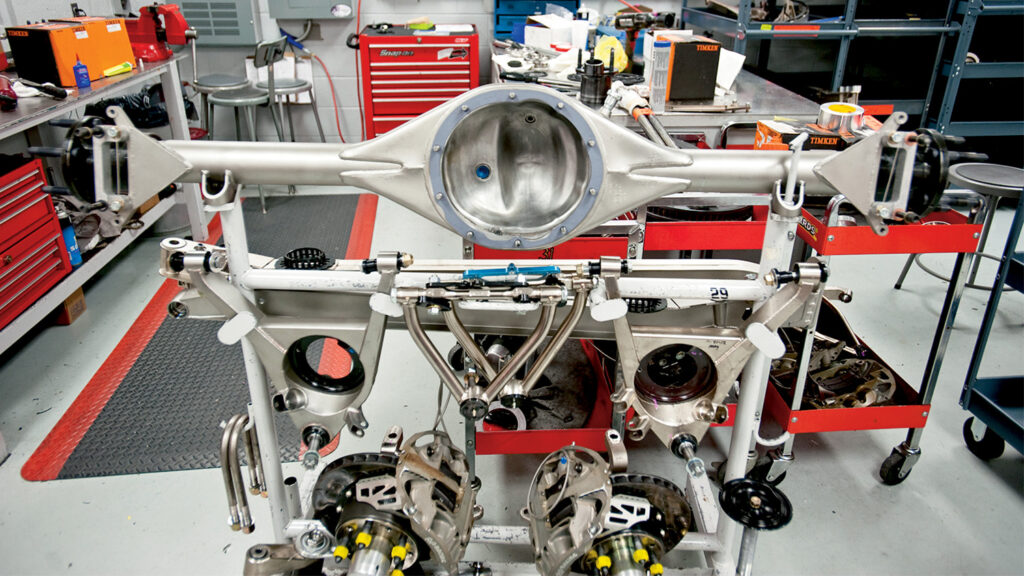
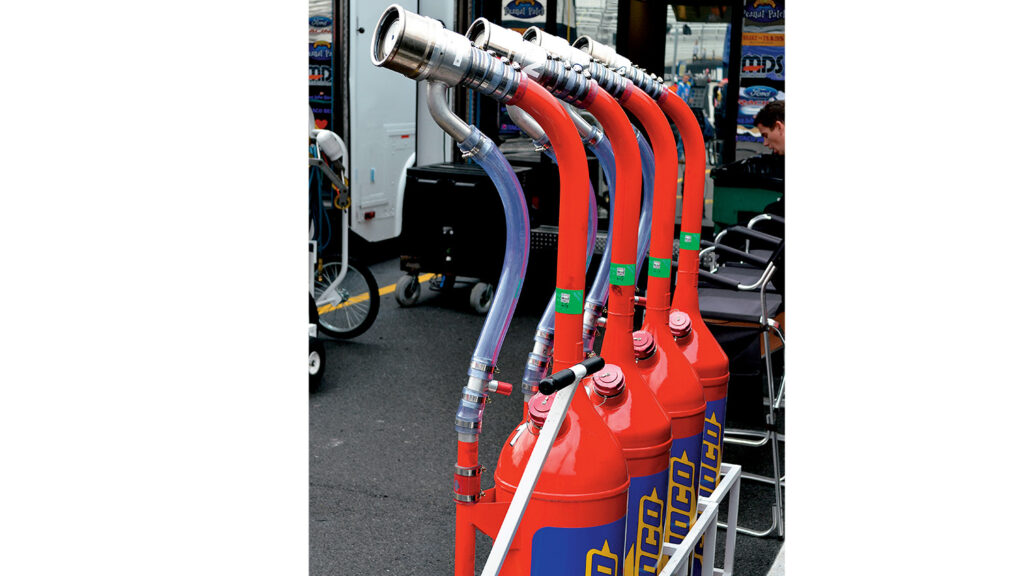
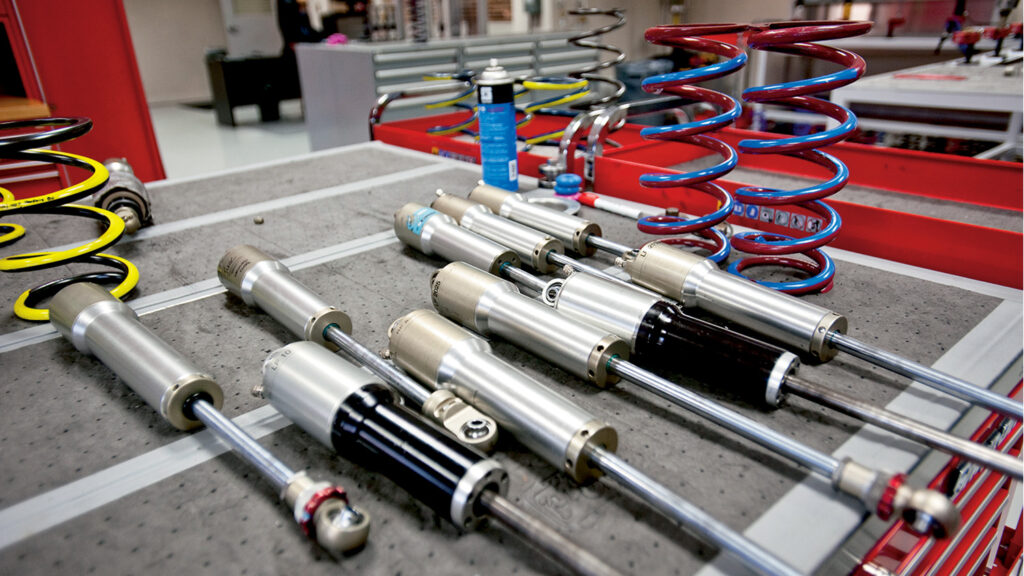
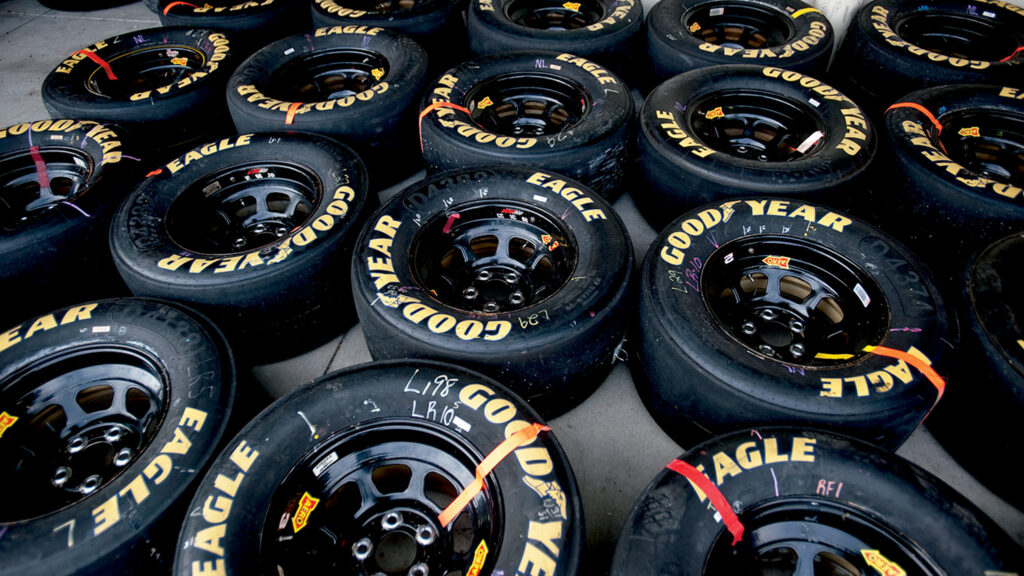
For Lambert, the bottom line is the finish line, leading even the most technically trained mechanical engineer to forsake the scientific method for what actually works. “And at the end of the day,” he says, “how you finish is what matters.”
- Categories:


